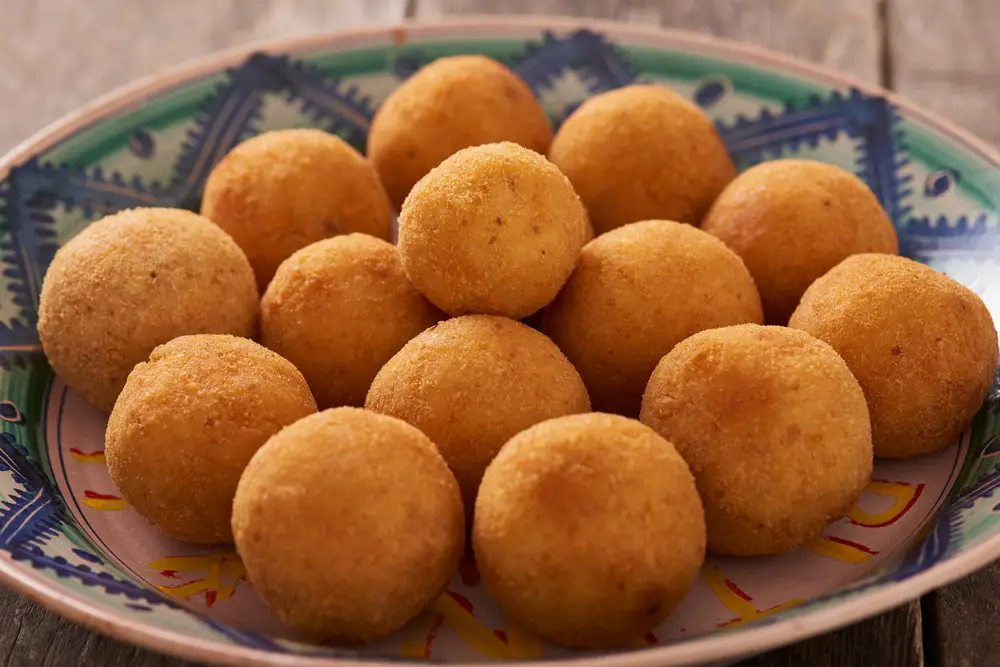Arancini (or Arancine as they are called in Palermo), the pride of Sicilian cuisine, are small timbales of rice suitable to be consumed both as a snack and as an appetizer, a first course or even a single dish.
In Sicily, you can find them everywhere and at all times, always hot and fragrant in the many shops. From city to city they often change shape and size: taking on oval, pear or round shapes. You can count about 100 variants: from the most classic with ragù and ham to the most original ones like pistachio and sepia!
The Rice Arancino, which owes its name to the aesthetic similarity with orange, is a typical product of Messina, Palermo and Catania, but is prepared according to tradition throughout Sicily. And every family maybe has its own homemade recipe.
According to some, the Arancini were born by the nuns in the convents. For others, they where born inside the rich baronial houses. Simply maybe they become from the traditional popular cuisine in order to recycle the the leftovers.
We explain you how to make the two timeless classics Arancini, with ragù of pork and peas and ham and mozzarella. Which do you prefer?

To prepare the rice arancini, start by boiling the rice in 1.2 l of salted boiling water, so that, once cooked, the water has been completely absorbed (this will allow the starch to remain all in pot and you will get a very dry and compact rice). Cook for about 15 minutes, then dissolve the saffron in very little hot water and add it to the now cooked rice. Add the chopped butter.
Add the grated cheese, mix well to mix everything, then pour and level the rice on a wide and low tray and cover it with the film, to make it completely cool, the film will prevent the surface of the rice from drying out. Let the rice rest for a couple of hours out of the refrigerator. Meanwhile, dedicate yourself to the stuffing with ragù: finely chop and slice the onion.
Stew the chopped onion in a pan with 2 tablespoons of oil and butter, then add the minced meat; let it brown over high heat, then add the wine and let it evaporate.
At this point add the tomato sauce, add salt and pepper to taste and cook over low heat for at least 20 minutes. Halfway through cooking, add the peas (if necessary you can add very little hot water because the sauce should be well coagulated and not liquid).
While the peas are cooked cut into cubes the Caciocavallo, the cooked ham and the mozzarella. Thus, you will have all the fillings ready.
Once the rice has cooled completely (it will take at least a couple of hours), you can form the arancini. To help you shaping, keep a bowl full of water nearby so you can wet your hands. Take a couple of tablespoons of rice at a time (about 120 grams of rice), mash the pile in the center of the hand forming a hollow and pour in a teaspoon of meat sauce, add a few cubes of caciocavallo.
Then close the base of the arancino with rice and shape it giving a pointed shape: you can give this shape to all the arancini stuffed with ragù. While for the ham filling, stuff each arancino (about 130 g of rice) with diced ham and mozzarella and shape them by giving them a round shape. This type of filling is traditionally called al burro (buttery).
Now that you have all the arancini ready, prepare the batter: in a bowl pour the sifted flour, a pinch of salt and the water flush. Mix thoroughly with a whisk to prevent it to form lumps.
Then dip the arancini, one by one, in batter, taking care to cover them completely and roll them in breadcrumbs.
In a saucepan heat the oil and bring it to the temperature of 170 °, then fry an arancino at a time or maximum two, to not lower the temperature of the oil: when they are golden brown you can drain them placing them on a tray lined with absorbent paper. Recommendation: enjoy the rice arancini hot!
You can keep the rice balls cooked in the refrigerator for a couple of days. Alternatively, you can prepare the rice the day before, cover it with plastic wrap and let it rest for one night in the refrigerator overnight.
You can freeze raw if you have used all fresh ingredients that have not been defrosted and fry them directly from frozen if necessary. This will prevent also them from crushing in the pan, if you are not so confident with cooking, then it could be a very cool trick!
If you want, you can replace the caciocavallo with fresh pecorino, provola or mozzarella.